When you think of bees, you might immediately picture a busy honeybee working on a sunlit flower. But bees are so much more diverse and exciting than many of us realize. They play a crucial role in our ecosystem, mainly through pollination, which is vital for the growth of many plants and the production of fruits and vegetables.
But let’s delve into something that often fills us with a bit of fear: bee stings. You’ve probably heard phrases like “what type of bees sting” or “what kind of bees sting.” These questions are quite common and for a good reason. Bees, known much as well as their stinging, are often misunderstood. The truth is, not all bees sting, and those that do usually only sting as a defense mechanism.
Honeybees, bumblebees, and Africanized honeybees are among the types of bees that can sting. However, not all bees have this ability; for instance, stingless bees, as their name suggests, do not sting. Each bee species has a unique approach to stinging, often influenced by their environment and behavior.
Now, are you curious about why a honeybee can only sting once while a bumblebee can sting multiple times? Keep reading our article to see which bees sting, why, what happens to them, and what to do if you’re stung!
The Anatomy of a Bee Sting
Have you ever wondered what happens when a bee stings? It’s quite a remarkable process! Inside a bee’s stinger, there are two main parts: a sharp, pointed lance and a venom sac. When a bee stings, the lance pierces the skin, and the venom sac releases its contents, which causes the familiar sting sensation. This stinger is actually a modified part of the bee’s body, making it an integral part of their anatomy.
It’s easy to lump all stinging insects together, but bees have a unique place in this group. Unlike wasps and hornets, which can sting multiple times, many bee species, like the honeybee, can sting only once. This is because their stingers are barbed, designed to stick in the skin of their target. When the bee flies away, the stinger remains lodged in the skin, along with part of the bee’s abdomen, leading to its demise. In contrast, wasps and hornets have smooth stingers, allowing them to sting repeatedly without harming themselves.
So, why do bees sting if it can be so costly to them? For bees, stinging is a last resort. They sting primarily to defend their hive and protect their queen, the heart of the bee colony. When a bee stings, it’s trying to defend its home and family. Each sting sends a signal to other bees, alerting them to potential danger. This act of self-sacrifice highlights the bee’s commitment to the safety and well-being of its colony.
Types of Bees and Their Stinging Habits
Did you know that there are over 20,000 different species of bees buzzing around the world? Each of these species has its own unique characteristics and behaviors, especially when it comes to stinging. Let’s explore some of these fascinating bees and understand their stinging habits!
Honeybees (Apis mellifera): The One-Sting Wonder
Let’s start with the honeybee, perhaps the most famous of all bees. The honeybee’s stinger is unique—it’s barbed, like a little harpoon. This design is effective for the bee’s defense but comes with a significant drawback for the bee. When a honeybee stings, these barbs anchor the stinger into the skin of the target. As the bee attempts to pull away, the stinger, along with a part of its digestive tract, muscles, and nerves, detaches from the bee’s body. This results in a fatal injury, leading to the bee’s death shortly after.
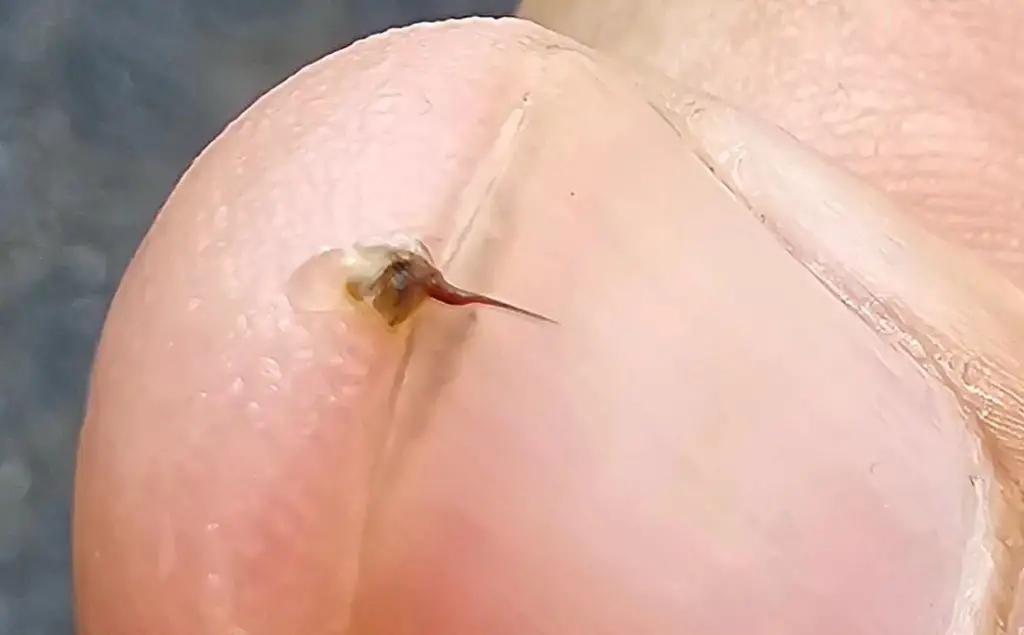
Why would an organism evolve such a seemingly self-destructive defense mechanism? The answer lies in the communal and highly cooperative nature of honeybee society.
Honeybees live in large, well-organized colonies, each with a single queen, worker bees, and drones. The survival of the hive, particularly the queen, is paramount to the survival of the entire colony.
When a honeybee stings, it does so to protect the hive. Along with the physical barrier created by the sting, the act releases pheromones that act as a signal to other bees in the colony.
These pheromones serve as an alarm, rallying other bees to come to the defense of the hive and ward off potential threats. This collective defense strategy underscores the sacrificial role individual bees play for the greater good of their colony.
Bumblebees (Bombus spp.)
When we think of bees that sting, our minds often jump straight to honeybees. But there’s another, fluffier kind of bee out there: the bumblebee. Bumblebees, belonging to the genus Bombus, are easily recognizable by their chubby, fuzzy bodies and gentle humming as they buzz from flower to flower.
One of the most endearing qualities of bumblebees is their docile nature. Unlike their honeybee cousins, bumblebees aren’t as quick to sting. They’re more interested in nectar and pollen than in what humans are doing. In fact, bumblebees are quite peaceful creatures and will usually only sting when they feel directly threatened or if their nest is disturbed.
So, if you see a bumblebee bumbling around your garden, there’s no need to worry – they’re just going about their business!
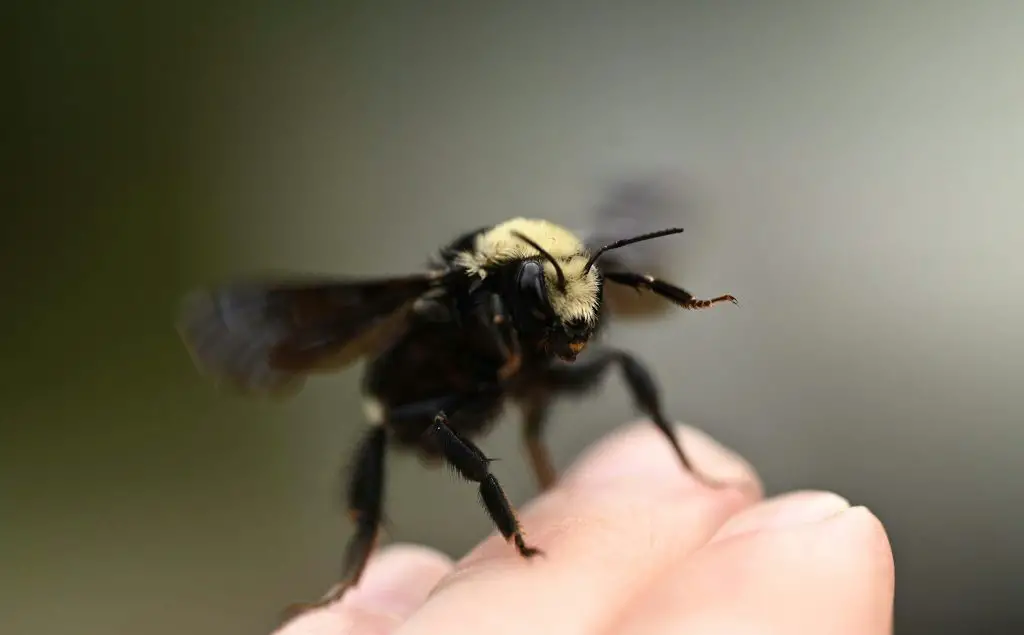
A Sting They Can Use More Than Once
Another interesting aspect of bumblebees is their stinging ability. Unlike honeybees, bumblebees can sting multiple times. This is because their stingers are smooth, lacking the barbs found in honeybee stingers.
So, when a bumblebee decides it needs to defend itself, it can do so multiple times without harming itself. However, due to their laid-back nature, it’s quite rare for bumblebees to resort to stinging. They would much rather save their energy for foraging and taking care of their nest.
Carpenter Bees (Xylocopa)
When exploring the world of bees and their stinging habits, we come across a fascinating and somewhat misunderstood group: the carpenter bees. These bees, belonging to the genus Xylocopa, are known for their ability to burrow into wood, creating tunnels to lay their eggs. But what about their stinging behavior?
Carpenter bees are generally very docile. They are not as eager to sting as some might think. In fact, these bees prefer to keep to themselves, focusing on their woodworking and foraging activities. They will only sting when they feel extremely threatened or provoked.
This is good news for us, as it means we can admire these industrious bees without much worry. If you encounter a carpenter bee, it’s best to give it space to buzz about its business peacefully.
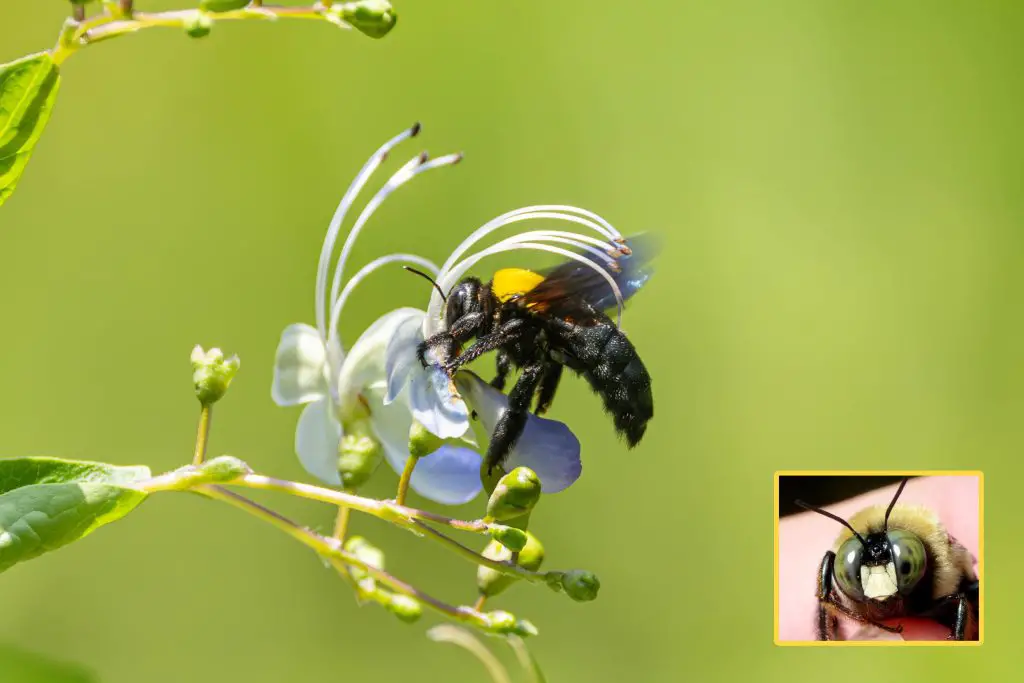
The Tale of Two Genders: Male vs. Female Carpenter Bees
Now, here’s where things get really interesting with carpenter bees: the difference between males and females. Male carpenter bees are often seen hovering around, guarding their territory. They might look intimidating and even make a dive towards you if you get too close. But here’s the secret: male carpenter bees cannot sting!
That’s right, they’re all buzz and no bite. On the other hand, female carpenter bees do have a stinger. However, they are very unlikely to use it unless they feel directly threatened.
So, while the males might be the ones getting in your face, it’s the quieter, less conspicuous females who have the ability to sting.
Africanized Honeybees (Apis mellifera scutellata)
In the world of bees, a species often surrounded by a bit of a buzz in the media is the Africanized honeybee, sometimes called the catchy name “killer bees.” These bees are a hybrid of the African honeybee and various European honeybees and have gained notoriety for their more aggressive behavior.
Africanized honeybees are known for their heightened defense mechanisms and readiness to sting. They’re more sensitive to disturbances and are quicker to mobilize for defense compared to other honeybee species. This quick-to-react nature is often interpreted as aggression. However, it’s important to understand that these bees are primarily acting out of a strong instinct to protect their hive.
Because of their defensive nature, it’s crucial to approach Africanized honeybees with extra caution. If you live in an area where these bees are present, it’s wise to be aware of their behavior. Should you encounter a swarm or a hive, the best course of action is to keep a safe distance. Disturbing or attempting to remove a hive without proper knowledge and equipment can be risky.
Professional Handling is Key
If you ever find yourself in a situation where you need to deal with an Africanized honeybee hive, seeking professional help is the best approach. Beekeepers and pest control professionals equipped with the right knowledge and tools can safely manage these situations, ensuring the safety of both people and bees.
Stingless Bees (Meliponini tribe): The Peaceful Pollinators
In the diverse world of bees, there’s a group that stands out for a very special reason: the stingless bees. These bees, part of the Meliponini tribe, are unique because, as their name suggests, they lack a functional sting. Let’s dive into the world of these gentle bees and learn what makes them so interesting.
Stingless bees are true to their name; they don’t have the ability to sting like their honeybee and bumblebee cousins. This might make you wonder, how do they protect themselves? Despite their lack of a sting, stingless bees are not defenseless. They have other methods of protecting their hive, such as biting or releasing a sticky resin to entangle intruders. While they might not pack a sting, they’re still quite adept at keeping their homes safe.
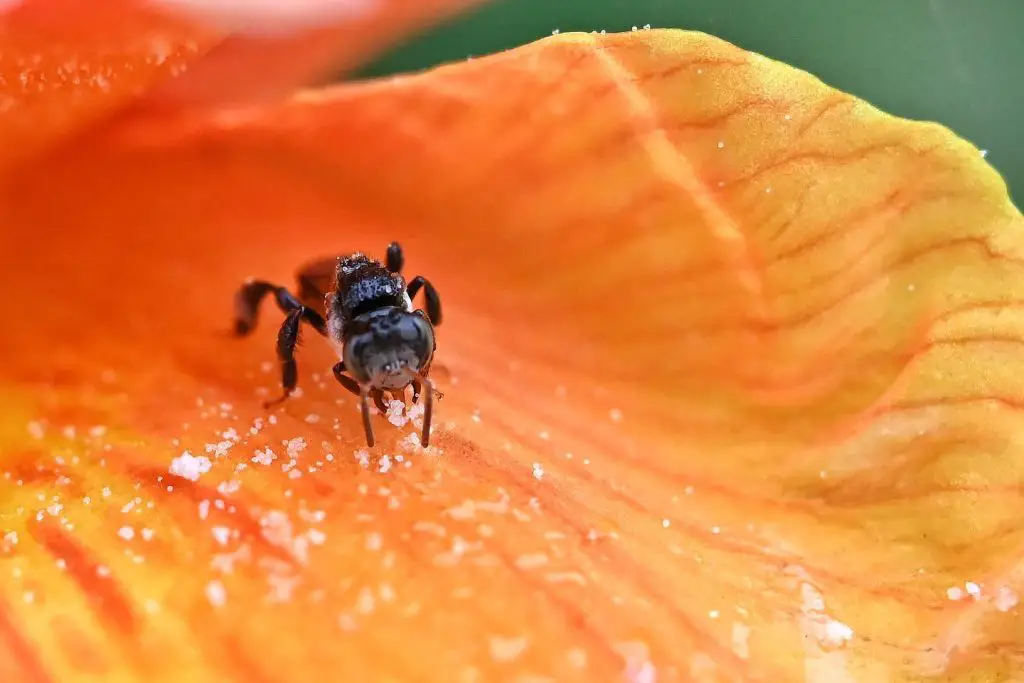
Defenders Without a Sting
Even without a stinger, stingless bees are not to be underestimated when it comes to defending their home. They might swarm around an intruder, using sheer numbers to intimidate. Some species can also be quite tenacious, using their jaws to bite if they feel their hive is threatened. It’s a fascinating adaptation, showing that nature always finds a way to equip its creatures with the means to survive and thrive.
Understanding Bee Behavior to Avoid Stings
When it comes to bees, many of us might feel a bit anxious about the possibility of getting stung. However, understanding bee behavior and knowing how to act around them can greatly reduce the chances of an unpleasant encounter. Let’s explore some best practices for sharing our space with these buzzing buddies.
The first and most important rule when encountering bees is to respect their space. Bees are generally not aggressive and will not sting unless they feel threatened. So, if you see bees buzzing around, it’s best to calmly and quietly move away. Swift movements or swatting at bees can make them feel threatened and increase the likelihood of them stinging in defense.
Tips to Keep the Peace
Here are some handy tips to remember when you’re around bees:
- Avoid wearing strong perfumes or scents, as these can attract bees.
- If a bee lands on you, stay calm. Gently blow on the bee or patiently wait for it to fly away.
- Be cautious around flowering plants, where bees are likely to be foraging.
- When eating outdoors, be mindful of sweet foods and drinks, as these can attract bees.
- Keep an eye out for bee nests or hives in your surroundings and give them a wide berth.
Recognizing Bee “Body Language”
Bees, like many creatures, have a way of communicating through their behavior. By understanding a bit of their “body language,” you can get a sense of when they might feel threatened. If a bee starts buzzing loudly, flying erratically, or raising its middle section (abdomen), it might be feeling defensive. In such cases, it’s best to slowly back away and give the bee some space. Remember, a bee’s primary goal is not to sting but to go about its business of foraging and caring for the hive.
What to Do If You Get Stung by a Bee
Despite our best efforts, sometimes a bee sting happens. It’s usually more of a surprise than a serious health issue, but knowing what to do can make all the difference. Here are some clear, step-by-step instructions to follow if you or someone around you gets stung by a bee:
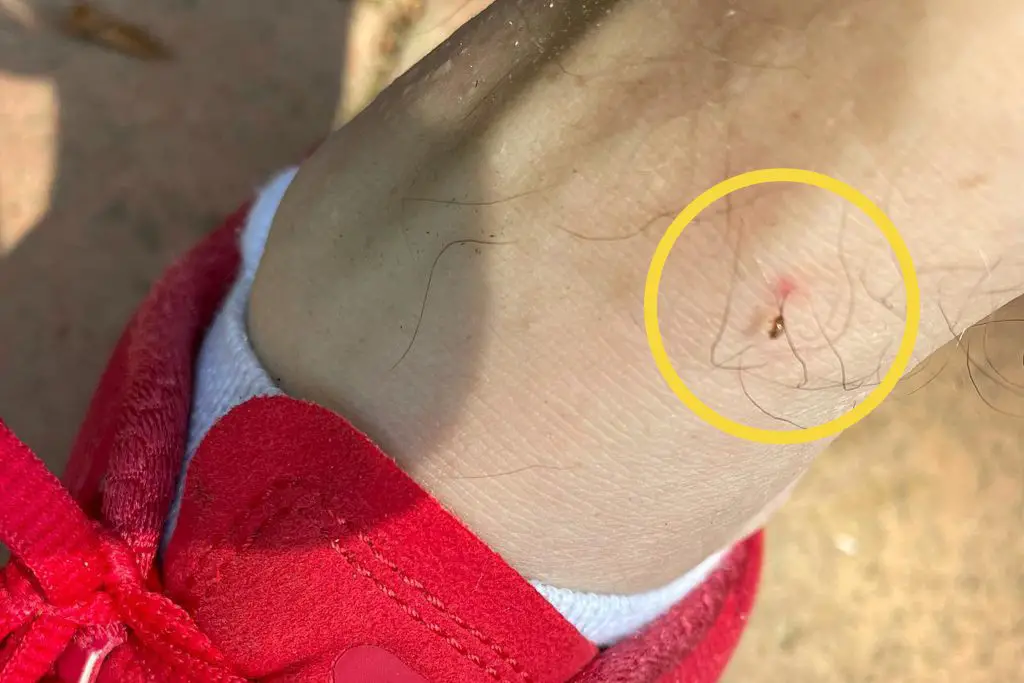
Ouch! A Bee Stung Me: Immediate Steps to Take
Step 1: Stay Calm and Move Away
- Keep Calm:
Try to breathe slowly and deeply. Panicking can exacerbate the situation by increasing your heart rate and spreading the venom more quickly. Remember, bee stings are usually harmless and manageable. - Move to Safety:
If you’re near a beehive, a swarm, or an area with many bees, walk away calmly. Quick movements or running might attract more bees. Find a place where you can safely assess and treat the sting.
Step 2: Remove the Stinger
- Look for the Stinger:
Honeybee stings are unique because the bee leaves its stinger (and part of its abdomen) in your skin. The stinger looks like a tiny black splinter. For stings from other bees (like bumblebees), this step can be skipped as they don’t leave a stinger behind. - Remove the Stinger Quickly:
The longer the stinger stays in, the more venom it releases. Using the edge of a credit card, fingernail, or a piece of gauze, gently scrape it out. Avoid using tweezers or squeezing the stinger, as this can squeeze more venom into the skin. The key is to be gentle but swift.
Step 3: Clean and Soothe the Area
- Clean the Sting:
Gently wash the area with soap and lukewarm water. This helps to prevent infection and removes any remaining venom on the surface of the skin. Pat the area dry with a clean towel. - Apply Ice:
An ice pack or a cold compress can significantly reduce swelling and numb the pain. Wrap the ice pack in a cloth or towel to avoid frostbite or irritation from direct contact with the skin. Apply the cold compress for 10-20 minutes every hour or as needed.
Recognizing When to Seek Medical Attention
Most bee stings are harmless and will heal on their own. However, there are situations when it’s important to seek medical attention:
- Allergic Reactions:
If you experience symptoms like difficulty breathing, swelling of the face, lips, or throat, dizziness, or a rapid heartbeat, seek emergency medical care immediately. - Multiple Stings:
If you’ve been stung multiple times, it’s wise to consult a doctor. - Sting in Sensitive Areas:
Stings in or near the eyes, mouth, or throat can be more serious and may require medical attention.
Additional Tips for Managing a Bee Sting
- Avoid Scratching:
It might be tempting, but try not to scratch the sting site. Scratching can irritate the skin and increase the risk of infection. - Use Over-the-Counter Remedies:
If the area is particularly itchy or swollen, over-the-counter remedies like hydrocortisone cream or oral antihistamines can provide relief. Always follow the instructions on the package. - Watch for Signs of Infection:
In the days following a sting, keep an eye on the site. If you notice increasing redness, warmth, swelling, or pus, consult a healthcare provider as these may be signs of infection.

Bee Sting Myths vs. Facts
There are many myths about bee stings. Let’s clear up some common misconceptions:
Myth: Putting vinegar or urine on a sting helps.
Fact: These substances are not likely to be helpful and may irritate the skin. Stick to cleaning with soap and water.
Myth: Bees always die after stinging.
Fact: While this is almost always true for honeybees, other bees like bumblebees can sting multiple times.
Myth: All bee stings are dangerous.
Fact: For most people, bee stings are a minor irritation. It’s only in cases of allergies or multiple stings that they pose a serious risk.
Respect for Bees [With a bonus of not getting stung!]
Living harmoniously with bees is not only beneficial for our environment, due to their importance in our ecosystems its almost essential. Understanding and respecting these incredible insects is key to coexisting safely and peacefully.
Appreciate from a Distance
- Observe, Don’t Disturb: Bees are fascinating to watch, but it’s important to do so from a safe distance. This respect for their space minimizes the risk of stings and doesn’t disturb their natural activities.
- Bee-Friendly Gardening: If you have a garden, consider planting bee-friendly flowers. This provides bees with much-needed nectar and pollen. Plants like lavender, sage, and sunflowers are great choices.
Stay Informed and Prepared
- Educate Yourself and Others: Understanding bee behavior and the role they play in our ecosystem can foster a greater appreciation. Share this knowledge with friends and family, especially children, to cultivate a community that respects bees.
- Know How to React: Familiarize yourself with the proper steps to take if a bee comes close or if someone gets stung. Staying calm and informed can prevent panic and unnecessary harm to the bees and people involved.
Conclusion
As we’ve explored the intriguing world of bees, it’s clear that understanding their stinging behavior is more than just about avoiding a sting. It’s about appreciating the diversity, complexity, and the essential role these remarkable insects play in our ecosystem. From the self-sacrificing honeybee to the peaceful stingless bee, each species has its unique story and contribution.
Let’s not forget that bees, regardless of their ability to sting or not, are vital pollinators contributing immensely to the health of our planet. By understanding them better, we can foster a sense of respect and appreciation for their presence in our world. And in doing so, we can also become advocates for their conservation, ensuring that these buzzing wonders continue to thrive and support the balance of nature.
As we wrap up our journey through the world of bees, remember that every encounter with these insects is an opportunity to observe and learn. Let’s continue to coexist with bees in a way that respects their space and recognizes their importance.
Frequently Asked Questions (FAQs)
Do bees sting other animals or just humans?
Bees primarily sting as a defense mechanism, and this can extend to any perceived threat, not just humans. This includes other animals that may pose a risk to their hive or themselves.
Can bees sense fear?
While bees can’t sense fear the way we understand it, they can detect rapid movements or increased carbon dioxide levels from heavy breathing, which might be associated with fear in humans. These reactions can make bees more defensive.
Why do some bees die after stinging but others don’t?
Honeybees die after stinging because their barbed stingers get lodged in the skin of their target, causing fatal damage to their own bodies when they try to fly away. In contrast, bees like bumblebees have smooth stingers, allowing them to sting multiple times without self-harm.

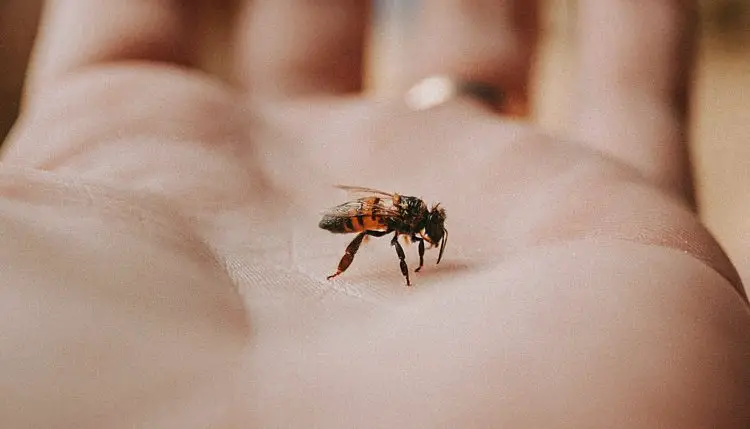
![3 Big Mistakes Beginner Beekeepers Make [And How To Avoid Them!]](https://beekeepingabc.com/wp-content/uploads/2020/11/3-mistakes-beginner-beekeepers-make-90x75.jpg)

![Move over ducks, Queen Bees quack too! [Here’s Why]](https://beekeepingabc.com/wp-content/uploads/2020/06/queen-bee-90x75.png)
![The Flow Hive 2 Review [ Vs. The Classic Flow Hive]](https://beekeepingabc.com/wp-content/uploads/2020/02/Flow-Hive-2-90x75.jpg)
![How Bees Fly [10 Facts About How, When, and Why]](https://beekeepingabc.com/wp-content/uploads/2019/12/A-Bee-Flying-90x75.jpg)